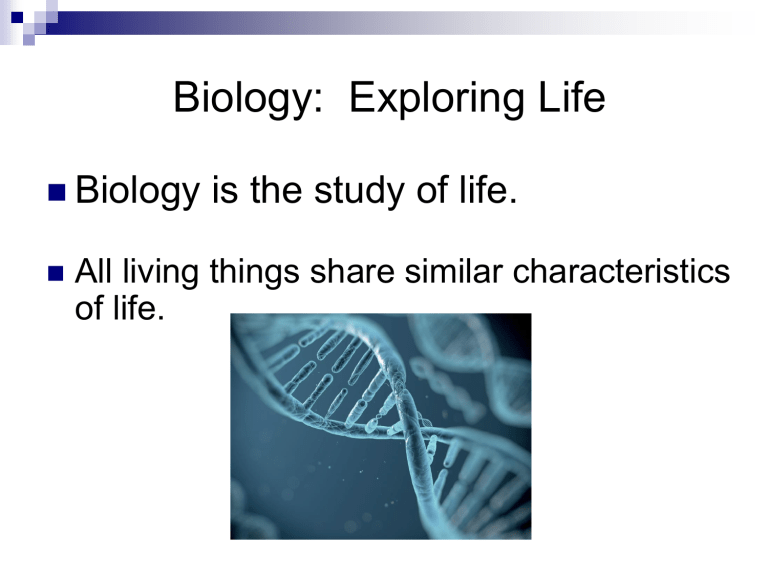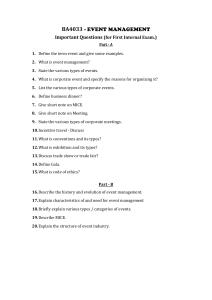
Biology: Exploring Life Biology is the study of life. All living things share similar characteristics of life. The basics 11 Characteristics of Life Development- a change in body form from immature to sexually mature The basics Organization of life Subatomic particles→ Atoms→ Molecules→ Macromolecules→ Organelles→ Cell→ Tissue→ Organ→ Organ system→ Organism Classification of living things Systematics groups species into categories based on their evolutionary relationships. Domain Kingdom Phylum Class Order Family Genus Species Human Domain Archaea • Contains unicellular prokaryotes (bacteria) • Prokaryotes= cells that lack a membrane-bound nucleus & cell structures. • Live in very harsh environments -halophiles= salt lakes -acidiphiles= soils -thermophiles= hot springs -methanogens= guts of humans, cows, etc. Domain Bacteria Bacteria are prokaryotic cells. They are found most everywhere. -skin -water -atmosphere -mouth Domain Eukarya Eukaryotes= cells with a membrane bound nucleus & cell structures Eukaryotes are divided into 4 kingdoms: 1) Protists 2) Fungi 3) Plants 4) Animals Taxomony is the assigning every species with a two part name (binomial). Bi= two Nomial = name Example: Pisum sativum (Garden pea The first part of the name is the genus and the second part is the species. You must underline the scientific name! Carolus Linnaeus Scientific Method- a process that is used to gather evidence that leads to understanding a particular topic The Scientific Method Scientific Words Complete these words on a vocab sheet in your folder. • • • • • • • Scientific Method • Hypothesis • Inferences • Independent • Variable Dependent Variable • Experimental Group Control Group Controlled Variable (Look up Constant) Analysis Conclusion Law Theory Every Experiment must have… Hypothesis- an educated guess based on prior knowledge; can be tested by experimentation Independent Variable- the one variable being tested, changed, and manipulated by the scientist (There is only ONE Independent Variable per experiment.) *goes on x-axis when graphing Dependent Variable- the variable that changes in response to the independent variable (usually it is what you are measuring/collecting data on) *goes on y-axis when graphing Remember that you NEVER prove anything; Your hypothesis is either accepted or rejected! Hints to remember IV vs DV __________ depends on ____________ (DV) (IV) Ex: Question- How does fertilizer effect plant growth? Hypothesis- If the plant receives more fertilizer than it will grow more. _Growth_ depends on Amount of fertilizer (DV) (IV) Let’s Test Your Brain Power! Read the following scenario and answer the questions. Identify: Homer notices that his shower is covered in a strange green slime. His friend Barney tells him that coconut juice will get rid of the green slime. Homer decides to check this out by spraying half of the shower with coconut juice. He sprays the other half of the shower with water. After 3 days of "treatment" there is no change in the appearance of the green slime on either side of the shower. Independent Variable 2. Dependent Variable 3. Control Group 4. Experimental Group 1. Control Group- must have one group/trial in the experiment that lacks the independent variable – used for comparison Experimental Group(s)- the groups/trials that contain the independent variable Controlled Variables- things that need to stay constant throughout the experiment Let’s Test Your Brain Power! Practice Bart believes that mice exposed to radio waves will become extra strong (maybe he's been reading too much Radioactive Man). He decides to perform this experiment by placing 10 mice near a radio for 5 hours. He compared these 10 mice to another 10 mice that had not been exposed. His test consisted of a heavy block of wood that blocked the mouse food. he found that 8 out of 10 of the mice exposed to radio waves mice were able to push the block away. 7 out of 10 of the other mice were able to do the same. Identify: 1. 2. 3. 4. 5. 6. Independent Variable Dependent Variable Control Group Experimental Group What should Bart’s conclusion be? How could Bart’s experiment be improved? Theory vs. Law Theory – an explanation of a natural phenomenon supported by many observations and experiments over time. Supported by evidence and enables scientist to make accurate predictions. Law – describes relationships under certain conditions in nature. Does not explain why an event occurs, just describes the relationship. Think: Individually, identify the following statements as “Theory” or “Law.” 1) 2) 3) 4) 5) A hypothesis that is supported by experimental results, many times. It cannot be explained why the relationship exists. All cells come from preexisting cells. When blowing a bubble into the air, a force acts upon it, causing it to fall to the floor. The event is justified by evidence and an explanation. Pair: With the people at your table discuss your answers. Share: What are the correct answers? The Answers Please! 1. 2. 3. 4. 5. Theory Law Theory Law Theory Crack Your Cranium 1. a. b. c. d. A controlled experiment allows the scientist to isolate and test ______. A conclusion A mass of information A single variable Several variables 2. Measurements of a plant’s growth over a two-week period represent ____. a.Inferences b.Variables c.Hypothesis d.Data The Organization of the Biosphere Biosphere: surface of the Earth (land, air, water) where life is found. Population: all members of a species in a particular area Community: made up of different populations Ecosystem: Organisms interact with each other and the physical environment.



